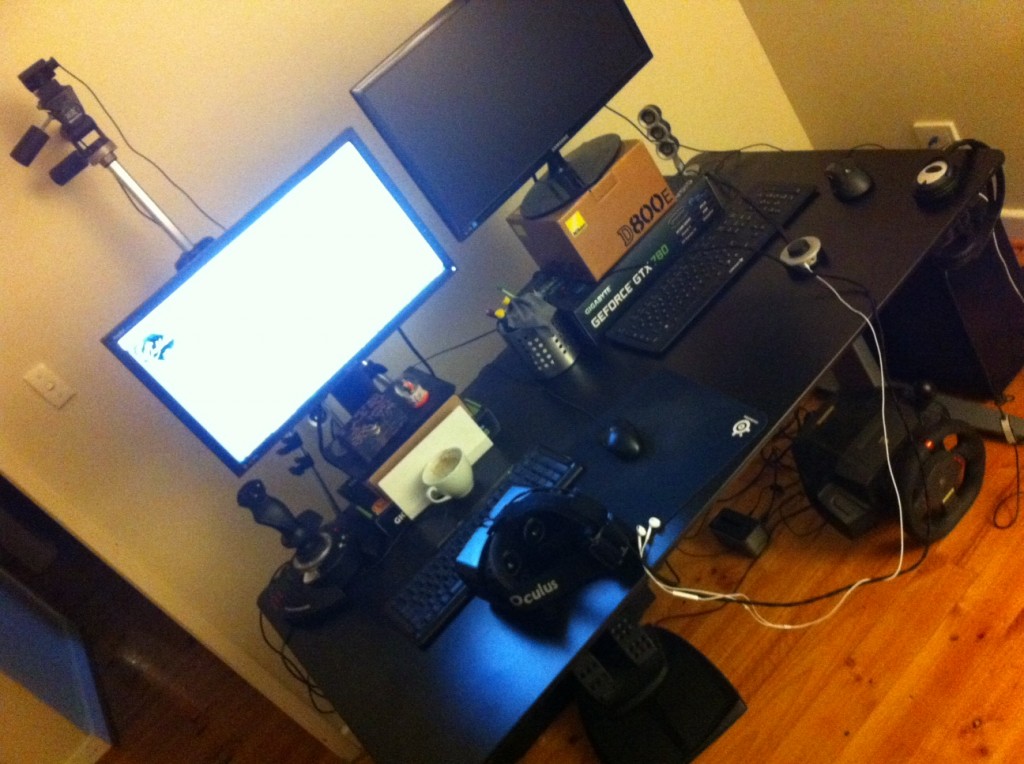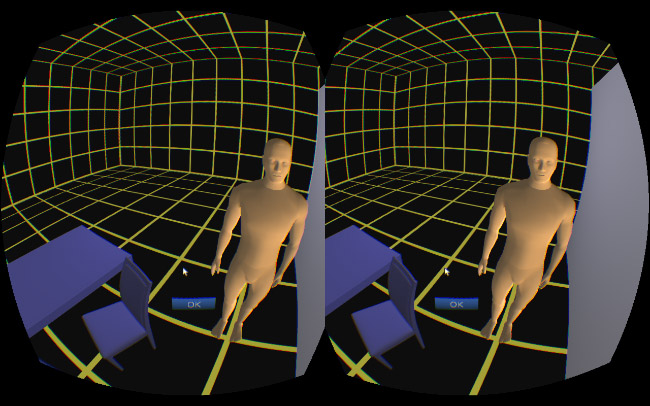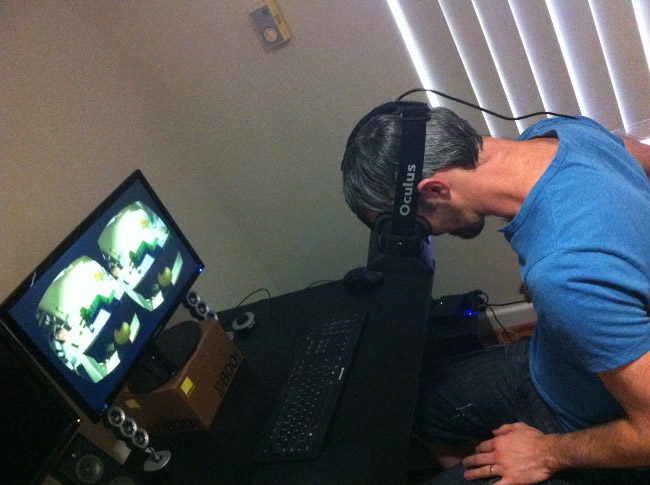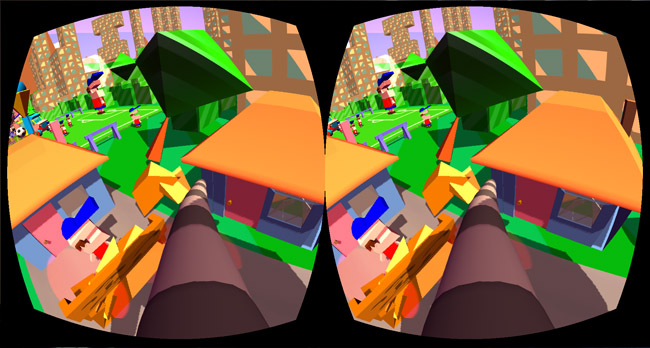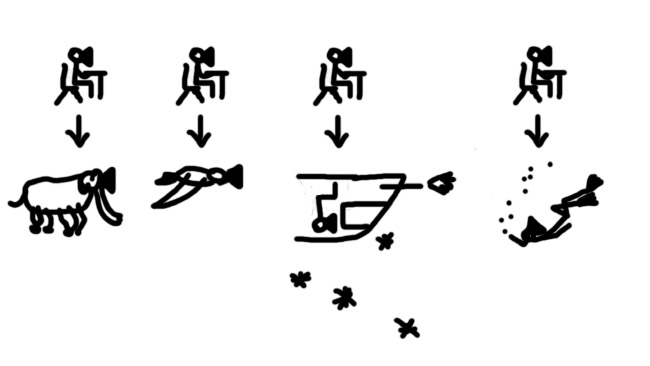Early last week I received my Oculus Rift DK2 after having developed some prototypes on the DK1 (un-released) last year. I wanted to put my thoughts down in a completely hype free manner, which I feel will probably make this one of the more level headed looks at the hardware. The hype right now is pretty crazy, especially from mainstream media/entertainment/games websites. So here’s what I think, starting with what I feel are the biggest downsides and short comings. Of course, some of this may or may not be solved for the release version:
Hardware setup and cables
During setup of the hardware, I was somewhat annoyed with all the cables required, and felt like it was quite a procedure to plug everything in and set up the camera. I have two computers in my home office, one of them in a standard (I guess?) setup where the case is on the right of my desk on the floor. For the DK1/normal case position, this was simple. For the DK2 I’ve now used a case behind my desk and so the cables are quite annoying. Inevitably speaker cables get mixed with Rift cables, and elbows yank on both as you decide whether to have them under or over your arm. If CV1 has headphones built in this will make this much better, as tangling cables does suck. I prefer using ear bud headphones so I don’t have double the things on my head.
Then you have to factor in that the Rift has to/wants to live somewhere on your desk, along with joysticks, mice and whatever else. You’ll pretty much be needing an input device like a controller or joystick for the Rift, so your desk just got double cluttered! A hook on the Rift somewhere would be great to just hang off the back of my monitor.
Camera
The camera is pretty much never going to be in a perfect position unless you have no monitor at all, or it’s magically off to one side. The 5 foot setup distance suggested is pretty unrealistic for most. Hopefully this distance is a DK2 feature and not permanent for CV1, because most people will need to mount this on their monitor, which is 2 feet away. When it’s this close, you’ll lose positional tracking past a certain (close) point to either side. If you put it farther back behind your monitor, you’ll lose positional tracking when you move your face in front of the monitor. To put it behind your monitor you need a tripod, wall mount or shelf. Sure these are all doable, but just inconvenient barriers for the normal consumer. A final point on the camera I’m unsure about – if it’s mounted on your monitor, I can’t imagine it doesn’t get knocked around a lot, messing with tracking in some way. Using a wheel or joystick is almost certain to shake everything around on your desk a little bit, including your monitor and Rift camera, disrupting or shaking your VR view(?).
Back to the cable situation – I think we still need some more customization/hooks/guides on the headset to direct them in a way that suits your setup. I hate the feeling of the cable around my neck/over my shoulder, but can’t really direct it away. I really want it just shooting off the right or left of the headset itself, but maybe you can feel the cable more that way, tugging directy at it rather than spread more evenly as it is now?
How’s your face feel?
Ok so what’s it like on your face? I’ve mostly played Elite Dangerous and Live for Speed, two of the best and most-working-est DK2 games out there. Every time I’ve played these games with the Rift, I’ve had to take it off and put it back on 2-3 times while it warms up and condensation stops forming on the lenses. So that’s pretty annoying. Once that’s settled it’s not too bad using it for around 30-60 minutes or so. After that point, I don’t know what to call it other than just fatigue. Whether it’s from the weight (it’s pretty light, though), it pressing against your face/nose bridge along with the heat, or looking at a low(ish) resolution screen, it’s hard to stay in for long. You might get some eye strain from trying to read all the now just legible text as well. Plus the foam that presses up against your skin isn’t the nicest.

From Kotaku’s article on being a space commander. I imagine my eyes look more tired and bloodshot!
The new lenses seem a little less forgiving than DK1 and require a more precise placement on your face to reduce the chromatic aberration effect, and the reduced FoV is noticeable when you’re looking for it, but not at all if you forget about it, same with the screen door effect.
Monitor > Rift > Monitor…
One of the biggest problems that will need solving is the awkward transition from monitor to Rift. This ranges from going from game to game (Rift off, select game, rift on, play game, quit game, rift off, new game, rift on…). Then you’ve got a key to recenter the rift, head set off… I’m pretty sure we will always need a re-center button(?), so maybe including one on the headset itself could be an idea? Often times I’ve been racing, wanted to reset, have to lean in to hit a key (my position is then different…) It’s a little awkward.
I almost think two buttons on the Rift could be great, one being recenter and another being ‘interface’/esc. Two buttons could do a multitude of tasks that would always be in reach, and would perhaps follow the design of Google Glass somewhat.
That Original Wow Effect?
I feel like a traitor to VR saying this, but I recall the first time I looked at a huge tree on a hill top in Minecraft and could barely believe my eyes. That tree was really truly “up there” and it was big! Now, with DK2’s new Minecrift it’s even better, there’s no motion blur, the frame rate is amazing, but now I’m used to the “VR effect”, and after a quick login/test play I didn’t get a repeat of this. I was still quite impressed with the views and increased resolution, the actually retch free playability of Minecrift. I made a little home in the mountain side, stretched my neck in all directions cutting down trees, and explored a few caves. Some of the views are great and the exploration sense is certainly heightened as you feel more that you’re actually inside these places. I’m more and more certain that it will all wear off, though. A second and third play through will likely feel a lot like playing vanilla 2D Minecraft again.
Awkwardly great
That kinda sums up the whole experience right now, awkward. Awkwardly pretty great, though. Yes it’s a dev kit, but the above points are what I see as some challenges to removing the Rift from the too-hard basket. Currently it is kinda in the same league as owning and using a steering wheel, requires similar levels of setup, and they occupy your desk in similarly annoying ways, subtly pushing you away from using them.
On the plus side for DK2? I can finally reaaaad! An amazing improvement in resolution that allows you to now actually play games and read instructions and interfaces! I can see into corners in Life for Speed and apex them properly, and only a little lean-in is required to read Elite’s interface text. The removal of the splitter box doesn’t really plus me that much, I never noticed it anyway once it was set up, and it’s been replaced by having to set up that camera.
The low persistence is really nice, and once devs have the software side working this improvement will become more apparent as we lose all judder, which is a slight problem with most demos made for Dk1 and tweaked for Dk2.
The number one thing worth talking about for me is positional tracking. Being able to move your head around in an environment both greatly adds to presence and opens up a number of game play situations. Looking around inside your ship in Elite is pretty amazing – doing simple things like standing up a little bit and looking over the front of your ship is great and really makes it sink in. Peering about the various cockpit objects for me is far more engrossing than looking out into space, potentially just because there’s so much more depth variation close up. I’ve also found myself peering over the bonnet of my car in LFS to see if I can see damage to a wheel, and I’ve thought how cool it might be to… I dunno, check my vehicle/space craft for holes/leaks/damage in some not yet existing game.
Top Moments with the DK2
My best moment so far has probably been playing Live for Speed, despite having logged more time in Elite. If you have the full game and the DK2, I highly suggest choosing the MRT (a small open cockpit car close to the ground) and the city track. The sense of speed is amazing, and flying through that concrete chicane at top speed and hearing your engines bounce off the walls as you clip them made me laugh out loud.
In Elite, I logged in with my brother and used in-game voice for a while. We also bumped into another player and text chatted with him. In both cases the feeling of communicating with other people who occupied a ‘real’ space was pretty amazing for reasons I can’t really explain too well, other than they really seemed to be there. Typing with the Rift on though, it’s a bitch!
In Minecrift, it was getting that sense that I was carving out my own 3-dimensional home in a mountain, and later looking up from within a recently discovered cave at a night sky.
Still just a novelty?
So what do I think about this awkwardly great Rift? I’m not entirely sure yet. Part of me feels like it is a bit of a novelty and it’ll all wear off. The DK1 was so radically new and different and amazing that perhaps you can’t help but feel slightly let down when the second one doesn’t do the same all over again (despite it being much improved). I’ll certainly still be one of the first to place an order for the release version.
In LFS, am I really using VR to its fullest advantage when mostly looking straight ahead? I’ll rarely have to use positional tracking, but I sure feel like I’m there at the track, and I have an improved knowledge of my position, barrier positions, turn in points, etc. For VR, I feel car racing fits nicely into that “you couldn’t do this in real life” category where the benefits of the technology directly helps the game genre by increasing the sense of speed and gives you the ability to look around at competitor positions. The biggest downside is that, if you don’t know how the car feels to drive, you’ll probably suffer from motion sickness no matter how good the hardware. If you’re “mysteriously” losing traction and spinning/drifting, you’ll feel a bit queasy.
In Elite, again positional tracking isn’t hugely needed, you mostly look forward or around for your target, and again I feel like a VR traitor (because I do actually love the Rift) but it’s just a bit of a step up from Track IR if you don’t consider the immersion and presence. Despite the fact that the game is now completely playable in the Rift, I still get the feeling that I don’t want to play this game, because I’ve played games like it many times before over the years. When you’re ‘really, truly inside that VR space station’, you’re still weighing up if I should buy space widgets here and sell them there, or take this mission to kill space bad guy number 999. Don’t get me wrong though, E:D is a really nice step up in many ways (those sound effects!) and I’m planning on doing a complete play through at some stage, hopefully with friends or family.
Should I discard my monitor?
Another thought, VR in these games isn’t so amazingly good that its pulled me away from my current favorite non VR game, Dota2. My point I guess is that I’ll probably still be playing non-Rift games if they’re more fun/challenging/engaging. VR won’t just make all games magically the best thing ever/throw your monitor out the window. Picture this extreme example, 50 years in the future we finally have “the holodeck”. You plug in and load up your house environment that was scanned a moment earlier. It’s perfect, you can’t tell the difference between reality and VR. Unfortunately, despite this technical marvel, I’d rather go play Dota2 in real life or VR life because it’s more fun and challenging than going “wow this seems so real!”. If the same thing became some kinda “X country just invaded, defend your family in your own home”, then great, I’m in! My point is, the experience or game still has to advance beyond the same shit just with VR tacked on. Whether I’d play Dark Souls 3 in VR mode or not, I’m not sure. I haven’t been bothered using VorpX or similar to try many traditional games other than Dear Esther.
But the immersion! The presence!
Obviously you can’t say a huge improvement in immersion or presence is not a big leap for gaming, but I think the best experiences are going to be emotionally deep ones, where the message the game is giving you is heightened. I think this is mostly true of all fiction and media, the best experiences are ones that touch you emotionally and once you’ve closed the book or left the cinema (or turned off the PS3/Journey!), you can’t help but keep thinking about that story. In Star Trek, on the holodeck, if you wanted to be moved, you’d load up stories or “holonovels”.
I love action games and competitive multiplayer which have no story or meaning, it’s probably what I play most often (Dota2 for example). However games like Eve Valkyrie I feel will kind of just top out at “wow this is cool”, in the same way we think 3D is cool for the latest action film. On the other hand, having an experience like Gone Home or Dear Esther that aims to do things with your emotions, and where the focus is the environment and story, that’s what I really can’t wait for. Feeling like you’re really inside the house from Gone Home, or on the island in Dear Esther could go beyond “wow this is cool”. The house in Gone Home is a huge part of the story and the feel of that game – if you believe you’re in that house, that would really add something above just cool-factor alone.
Positional game mechanics
If we step away for a moment from any talk of story, and instead look at pure mechanics, I think the Rift doesn’t add a lot more (yet) other than positional tracking, which certainly has a lot of potential. I’d like to see something up close and personal like The Room where you’re actively peering around and inspecting objects. Or as I said above, something where I need to inspect the vehicle I’m sitting in for damage. Something that really uses positional tracking. Super Hot seems to do this with its bullet dodging/time mechanics so I’m keen to try it. A lot of positional movement has already been covered a lot just by use of controllers for things like leaning around corners so I’m still not too sold on this being a huge thing for pushing game mechanics further.
My latest prototype
Maybe if we do something that combines both of the above things? Emotionally deep games where you inspect objects in your highly immersive environment, to help tell a story? This is what I’m working on right now – I’m prototyping stuff anyway! Being a mostly 1-man team I’ll have to choose something that’s possible within that scope, but I hope to tackle a game that only the Oculus Rift can do justice to. I’ll keep you up to date as I develop it. If you’d like to stay tuned, read more posts like this or be notified of demo releases in the future, you can sign up below:

